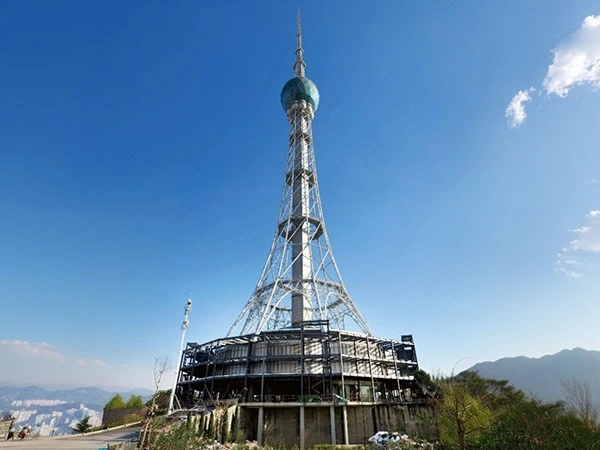Building Use:Commercial
Area:7000m²
Steel Usage:2000 t
Factory Structure and Project Features:Steel structure frame
Project Challenges & Overcoming Process:
Steel frame structure with tight schedule and complex joints, full-process laser cutting used to improve component accuracy and achieve high-standard delivery.

A steel structure TV tower is a tall, self-supporting or guyed structure made from steel, designed to support antennas for telecommunications and broadcasting, including television signals. These towers are engineered to withstand significant environmental forces like wind and seismic activity. The most common type is a steel lattice tower, which provides a strong, lightweight structure and is often tapered toward the top to improve stability.
High Strength-to-Weight Ratio: Steel offers incredible strength without being excessively heavy. This is crucial for building a tall, slender structure that can support its own weight, the weight of antennas, and withstand environmental forces.
Durability and Resilience: Steel can be treated (e.g., galvanized or painted) to resist corrosion from rain, snow, and atmospheric pollutants, ensuring a long service life. It is also ductile, meaning it can deform under extreme loads (like high winds or earthquakes) without catastrophic failure.
Prefabrication and Speed of Construction: Steel components can be precisely manufactured in a factory and then transported to the site for assembly. This off-site fabrication speeds up construction, improves quality control, and reduces on-site labor.
Versatility: Steel can be easily formed into various shapes, allowing for the creation of efficient and architecturally interesting designs, such as the complex latticework seen in many towers.
Recyclability: Steel is 100% recyclable, making it a more sustainable choice compared to other materials.
Designing a steel TV tower is a complex engineering challenge that must account for numerous forces and factors.
Wind Loading: This is the most critical design factor. The tower must be able to withstand hurricane-force winds. Engineers perform detailed wind tunnel testing and computational fluid dynamics (CFD) analysis to understand how wind will interact with the structure, including phenomena like vortex shedding which can cause vibrations.
Seismic Loads: In earthquake-prone regions, the tower must be designed to withstand ground shaking without collapsing.
Ice and Snow Loading: In cold climates, the accumulation of ice on the steel members can dramatically increase the weight and wind-facing surface area of the tower.
Foundation Design: The foundation must safely transfer all vertical and lateral loads from the tower into the ground. Soil conditions at the site are a critical factor in foundation design.
Fatigue: The tower is constantly subjected to fluctuating wind loads, which can cause metal fatigue over time. The design must ensure all connections and members can endure millions of stress cycles.
Antenna Requirements: The top of the tower must be stiff enough to prevent excessive swaying, which could misalign directional antennas and disrupt signals.
Safety and Maintenance: The design must include access systems like ladders, elevators, and platforms for workers to safely inspect, maintain, and upgrade the broadcasting equipment. Aviation warning lights are also a mandatory safety feature.

Create the greatest value for customers
Provide the best quality products and services
+8618800767079
info@hcggsteel.com
No.1 Shuangxiang Road, Luoxin Industrial Park, Luoyang City